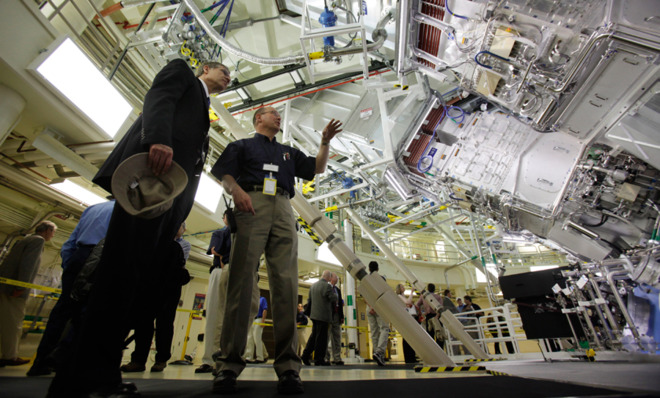How science came one step closer to the holy grail of nuclear fusion
Cheap, clean, virtually limitless fuel may someday be a reality

Thanks to the work of a group of scientists at the National Ignition Facility in Livermore, California, the world has just taken a big step closer to what has been called the "holy grail" of energy: Nuclear fusion.
Using 192 beams from the world's most powerful heat laser, scientists were able to reach an important milestone in turning nuclear fusion into a practical energy source. At the National Ignition Facility's lab, "the amount of energy released through the fusion reaction exceeded the amount of energy being absorbed by the fuel," says the BBC — a first ever in the history of fusion energy.
For the uninitiated, nuclear fusion is the opposite of nuclear fission, the process we use to generate nuclear energy today. Fission is splitting one atom into two, whereas fusion is combining two atoms into one. Unlike fission, fusion occurs naturally in stars, like the sun, and produces less radioactivity. It also generates four times more energy.
The Week
Escape your echo chamber. Get the facts behind the news, plus analysis from multiple perspectives.

Sign up for The Week's Free Newsletters
From our morning news briefing to a weekly Good News Newsletter, get the best of The Week delivered directly to your inbox.
From our morning news briefing to a weekly Good News Newsletter, get the best of The Week delivered directly to your inbox.
Nuclear fusion, if harnessed, would produce minimal greenhouse gases, no chain reaction (making it safer than fission), no nuclear waste, and cheap, "virtually limitless" fuel.
So, what's the hold up?
To begin with, nuclear fusion is incredibly difficult to produce, and even harder to scale up. Because only opposite charges attract, two hydrogen atoms of the same charge won't come together without tremendous heat — "somewhere in the neighborhood of 12 million degrees C," says Triple Pundit. That creates all sorts of difficulties. Per Triple Pundit:
Producing these kinds of temperatures in what is essentially a synthetic sun is a great engineering challenge. The elements are heated until they reach a plasma state. No material could possibly withstand such heat without melting, which is why the reacting elements must be suspended without touching the walls in the vessel. [Triple Pundit]
Of course, humans have figured out the preceding steps when scientists developed the hydrogen bomb, "in which all the tremendous energy of the reaction is released at once in a highly destructive manner," says Triple Pundit. But harnessing that power to create a controlled reaction and a commercially viable energy source has remained out of reach.
A free daily email with the biggest news stories of the day – and the best features from TheWeek.com
"To be viable," says the BBC, "fusion power plants would have to produce more energy than they consume, which has proven elusive." While taking a step closer to that dream scenario with its latest breakthrough, The National Ignition Facility still has major challenges before overall energy output matches input. Despite the fact that the reaction was able to release more energy than it absorbed from its fuel, the test machine as a whole suffered from "'inefficiencies' in different parts of the system," according to the BBC, that kept it from reaching its goal.
Nevertheless, breaking the threshold of energy input from fuel vs. output in the reaction itself is a big step for the lab and possibly, says the BBC, "the single most meaningful step for fusion in recent years."
Carmel Lobello is the business editor at TheWeek.com. Previously, she was an editor at DeathandTaxesMag.com.
-
 Political cartoons for December 15
Political cartoons for December 15Cartoons Monday’s political cartoons include Time's person of the year, naughty and nice list, and more
-
 Who is fuelling the flames of antisemitism in Australia?
Who is fuelling the flames of antisemitism in Australia?Today’s Big Question Deadly Bondi Beach attack the result of ‘permissive environment’ where warning signs were ‘too often left unchecked’
-
 Bulgaria is the latest government to fall amid mass protests
Bulgaria is the latest government to fall amid mass protestsThe Explainer The country’s prime minister resigned as part of the fallout